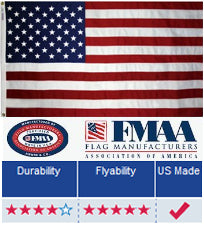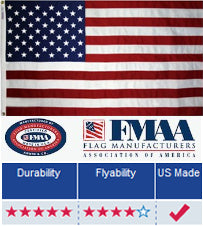ARMED FORCES HISTORY AND FLAG ETIQUETTE
The order of precedence when displaying military flags together is Army, Marine Corps, Navy, Air Force and Coast Guard. Except that Coast Guard moves up right behind Navy when the Coast Guard serves as a service of the Dept of the Navy in time of war.
The basic citation is Department of Defense Directive 1005.8.
 |
The U.S. Army flag bears a blue replica of the official War Office seal over a white background. Underneath the seal is a white writing over a red field that reads "United States Army". Underneath is the date 1775, which stands for the year the Army was established with George Washington being the Commander-in-Chief. President Dwight Eisenhower is the one who gave the flag an official status in June of 1956. There is a lot of history behind the U.S. Army flag. The concept of this flag appeared in the midst of the Civil War, more specifically when the War Department instructed regiments to inscribe the names of battles on the colors of their country, in other words, on the American flag. Evidently, the U.S. Army flag was created to show the Army as a whole, and all their campaigns. |
 |
The U.S. Marine Corps flag was created on January 18th, 1939. The flag is commonly known as a "standard" or "battle color". It comes with a scarlet writing over a white field and has the Corps emblem in gold and grey. There are two versions of the flag, one bordered with a gold fringe and used for parade and indoor sessions while the other, plain, displayed outside. The flag measures fifty-five inches by sixty-two inches. The staff comes with multi-colored battle streamers at the very top and sterling silver bands, with engraved names of each conflict of the Marine Corps.The flag of the Corps is always carried by the Color Sergeant. This position was first established in 1965; the first Color Sergeant was Gunnery Sgt. Shelton L. Eakin. All Sergeants are eligible to take the position for two years, the only two requirements for applicants are the proper height (6 feet, 4 inches tall), and the White House security clearance. There are no exact records about the flags used by first American Marine Corps. It is believed, though, that the Grand Union Flag was first carried ashore by Captain Samuel Nicholas and his battalion on New Providence Island in 1776. The Gadsden flag was probably carried at this same mission. |
 |
The U.S. Navy flag bears the Seal of the Department of the Navy in the center. Below is a blue text reading "United States Navy" over a yellow field. The color of the letters matches the color of the background of the entire flag. The unofficial predecessor of the current U.S. Navy flag was the Infantry Battalion flag flown by the Navy during drills and ceremonial occasions. Like the U.S. Army flag, the official U.S. Navy flag was adopted by President Dwight Eisenhower in April 1959. The flag is often used in ports, during parades and other celebrations. It is never displayed on ships at sea or on poles at naval land installations. Instead, the U.S. Coast Guard Ensign is used to identify U.S. ships and facilities. The flag is 4 feet and 4 inches by 5 feet and 6 inches, with the Seal in the center measuring 2 feet and 6 inches in diameter. |
 |
The U.S. Air Force flag bears a coat of arms, thirteen white stars, and the Air Force Seal over a blue background. The stars, similar to the original U.S. flag, represent the original thirteen colonies that became the first states of the Union. Three of the stars clearly stand out, as they are intercepted by the eagle's wings; they represent the Departments of National Defense which include the Army, Navy and Air Force. Below the crest of the flag is the famous American bald eagle over a cloud-like formation, which symbolizes creation of a new firmament. Similar to the U.S. Marine Corps flag, there are two versions of the flag. The flag used indoors and during parades is bordered by a gold fringe, whereas the outdoor version is plain. The U.S. Air Force flag was adopted by President Harry Truman in March of 1951 and since then no major adjustments have ever been made to it. |
 |
The U.S. Coast Guard flag comes with the Great Seal of the United States over a white background. In the middle of the seal, an eagle bears a shield with red and white vertical stripes, and a thick horizontal blue stripe. Above is an arc reading "United States Coast Guard"; below is the famous saying "Semper Paratus", which means Always Ready... beneath the words is the date 1790, which stands for the year when the Revenue Cutter Service, the U.S. Coast Guard predecessor, was founded. The first flag of Revenue Cutter Service was flown in 1799 to help distinguish its ships from commercial vessels. The ensign had 16 perpendicular stripes, alternate red and white, which matched the number of the states in the Union at that time. Later the flag's background was changed to white, with a blue eagle and the saying over it. In January 1968, the U.S. Coast Guard flag was awarded the official status. |


